Unit 6 Enjoying Cycling Topic 3 Bicycles are popular with people.
文档属性
| 名称 | Unit 6 Enjoying Cycling Topic 3 Bicycles are popular with people. | 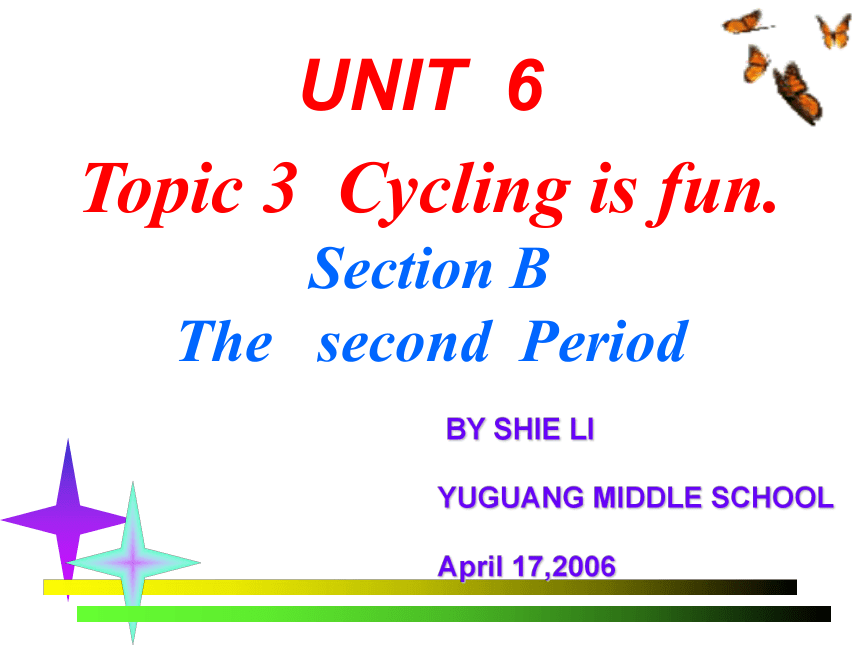 | |
| 格式 | rar | ||
| 文件大小 | 921.1KB | ||
| 资源类型 | 教案 | ||
| 版本资源 | 仁爱科普版 | ||
| 科目 | 英语 | ||
| 更新时间 | 2009-02-03 11:13:00 | ||
图片预览

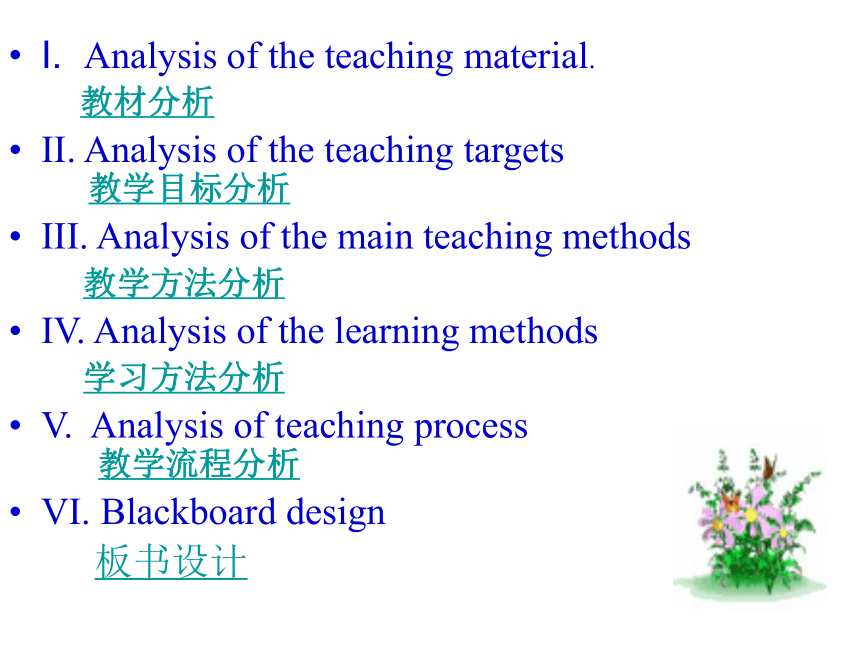


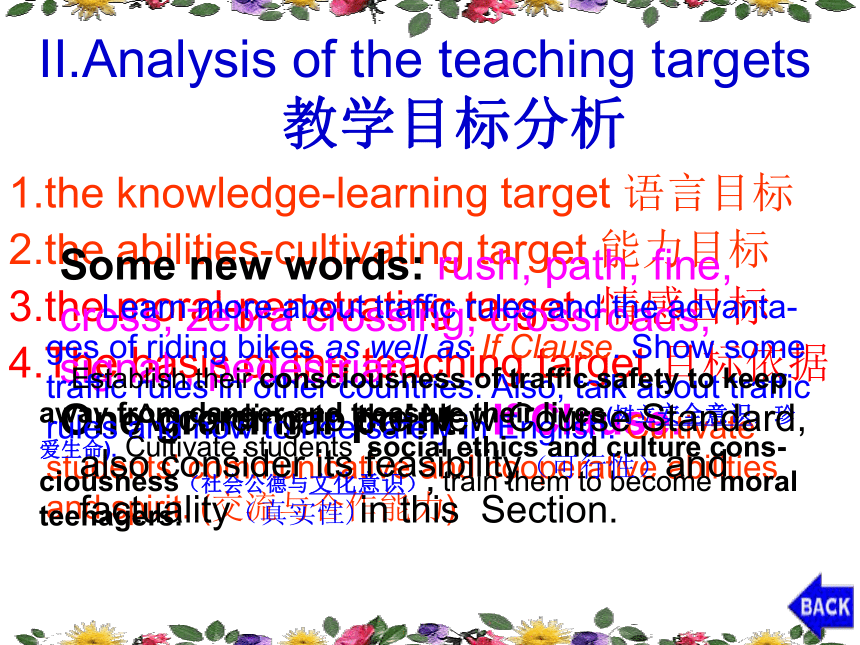

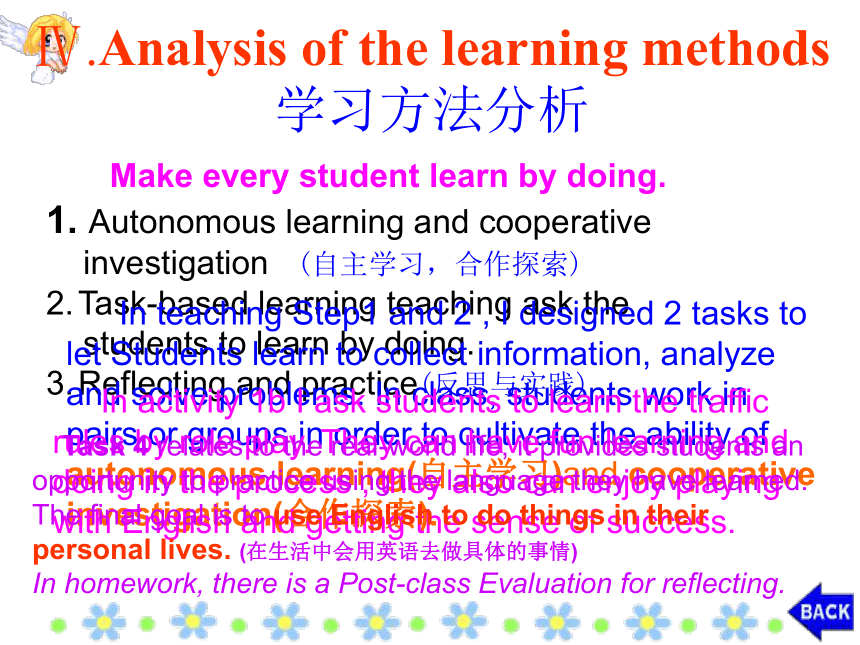
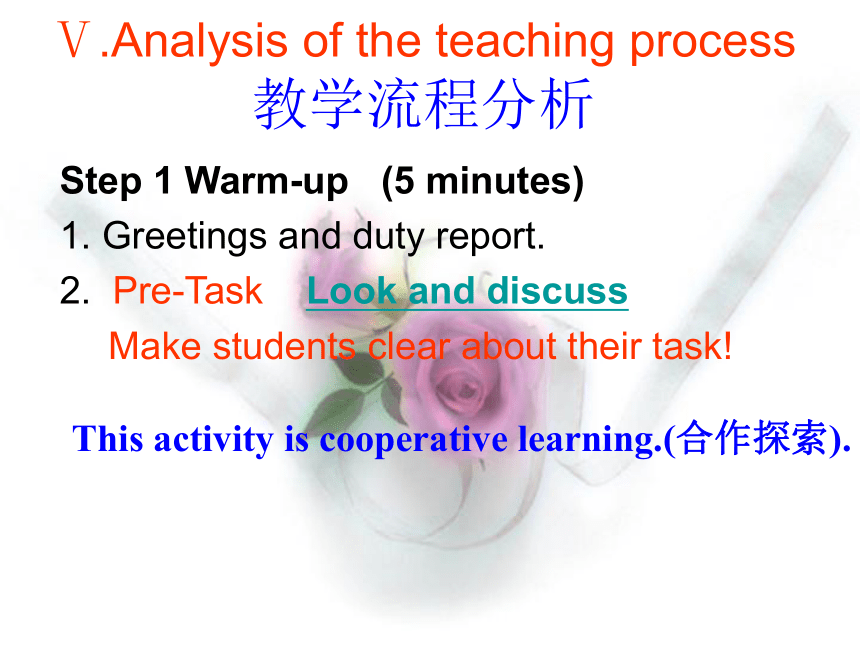
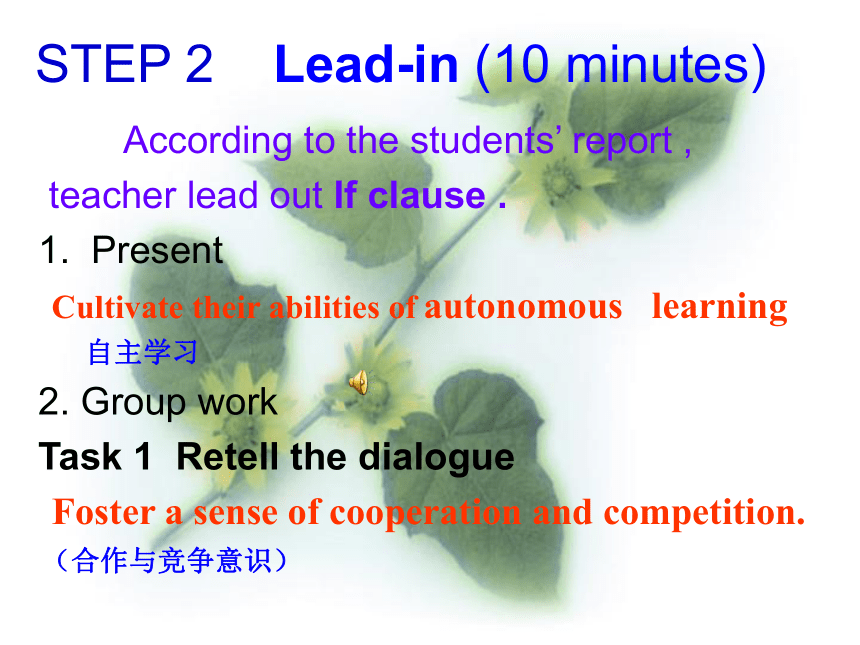
文档简介
课件24张PPT。UNIT 6Topic 3 Cycling is fun.
Section B
The second Period
BY SHIE LI
YUGUANG MIDDLE SCHOOL
April 17,2006
I. Analysis of the teaching material.
教材分析
II. Analysis of the teaching targets 教学目标分析
III. Analysis of the main teaching methods
教学方法分析
IV. Analysis of the learning methods
学习方法分析
V. Analysis of teaching process 教学流程分析
VI. Blackboard design
板书设计
Thank you! I. Analysis of the teaching material.
教材分析 The position and the effect of the teaching material教材的地位与作用
2.The contents and key features of the teaching material教材的内容和特点
3.The focus and difficult points 重、难点
4. The settlement of the teaching material
教材的处理
According to the course standard and the position of this unit in the teaching material.The focus: 1) If Clause. 2) Build students’ the consciousness of traffic safety ,educate them to Obey the rules and treasure their lives.
The difficult points: If Clause. Through a step-by-step progression, Project English is to build students’ confidence, lead them to open-ended activities and make language learning motivating and successful ,what’s more, students can actively relate learning to their personal lives. On the basic of Unit 6 Students’ Book B for Grade Seven, students will learn more about traffic signs、 rules and warn-ings and also come across If Clause in this Unit(Unit6).
Section B, seen as an essential component of this Unit, continuous with several step-by-step practice activities. Each activity focuses on the target language in an easily understand-
able way. It gets ready for the further study.1.the knowledge-learning target 语言目标
2.the abilities-cultivating target 能力目标
3.the moral-penetrating target 情感目标
4.The basis of the teaching target 目标依据II.Analysis of the teaching targets 教学目标分析Some new words: rush, path, fine, cross, zebra crossing, crossroads, signal , pedestrian,
One grammar point. If Clause. Learn more about traffic rules and the advanta-ges of riding bikes as well as If Clause. Show some traffic rules in other countries. Also, talk about traffic rules and how to ride safely in English. Cultivate students’ communicative and cooperative abilities and spirit. (交流与合作能力) Establish their consciousness of traffic safety to keep away from danger and treasure their lives(树立安全意识,珍爱生命). Cultivate students’ social ethics and culture cons-ciousness(社会公德与文化意识), train them to become moral teenagers. According to the New Course Standard, also consider its feasibility(可行性)and factuality(真实性)in this Section. Ⅲ. Analysis of the teaching methods
教学方法分析 1.Task-based teaching method:
任务型教学方法
2. Learning by doing (做中学,学中做 )
3. Contest teaching method: 竞赛教学法
4. Teach English in English: 用英语教学
5. Using multi-computer:
借助多媒体等辅助教学 The new course standard points out, the teacher should design the teaching activity regarding students as the centre, pay close attention to each student, each student’s mood life and emotion experience, ethical life and personality building. (关注每一位学生,关注学生的情绪生活和情感体验,关注学生的道德生活和人格养成.) The course standard also points out: In English class, we advocate students’ positive participa-tion (积极参与) , improve their language ability through perc-eiving, experience, participation and cooperative learn-ing(感知,体验,参与实践,合作探究).So I apply the different kinds of teaching methods: In order to train students to learn by themselves. I design 4 tasks . The teacher instructs students to acquire the knowledge, the overall abilities and the skills constantly during proceeding different kinds of individual or cooperative activities. New course idea of “learning by doing” is very welcomed by students. So I design tasks and an English song in order to make students relax while studying. Both Task 1 and 3 are competitions between groups. Students should cooperate in their own group at the same time they compete with the other groups. This can help students foster a sense of cooperation and competition.(合作意识与竞争意识) Try to teach in English, create the good atmosphere for students to perceive fully, experience actively, practice bravely(充分感知,积极体验,大胆实践).Use tasks, drills, liste-ning practice, pair work and group work to stress the key points(突出重点)and break through the difficult points(突破难点). Draw supports from the courseware and vivid pictures .Other aids such as gesture, body language.Ⅳ.Analysis of the learning methods
学习方法分析 Make every student learn by doing.
?Autonomous learning and cooperative
investigation (自主学习,合作探索)
Task-based learning teaching ask the
students to learn by doing.
Reflecting and practice(反思与实践)
In teaching Step1 and 2 , I designed 2 tasks to let Students learn to collect information, analyze and solve problems. In class, students work in pairs or groups in order to cultivate the ability of autonomous learning(自主学习)and cooperative investigation(合作探索). In activity 1b I ask students to learn the traffic rules by role play. They can have fun learning and doing in the process , they also can enjoy playing with English and getting the sense of success. Task 4 relates to the real-world life, it provides students an opportunity to practice using the language they have learned. The final goal is to use English to do things in their personal lives. (在生活中会用英语去做具体的事情)
In homework, there is a Post-class Evaluation for reflecting.Ⅴ.Analysis of the teaching process 教学流程分析Step 1 Warm-up (5 minutes)
1. Greetings and duty report.
2. Pre-Task Look and discuss
Make students clear about their task!
This activity is cooperative learning.(合作探索). STEP 2 Lead-in (10 minutes) According to the students’ report ,
teacher lead out If clause .
1. Present
Cultivate their abilities of autonomous learning
自主学习
2. Group work
Task 1 Retell the dialogue
Foster a sense of cooperation and competition. (合作与竞争意识)
The key words:
A: …obey…red … green…
B: Pedestrians must obey…don’t …cross …
C: …should…if…use…or…
D: …For example…special cycle paths…avoid…
E: If…break…fine Show some pictures.
Play the tape, students learn while listening
and reading. Help them recite.
Role play. (learning by doing, getting the
sense of success. 做中学,学中做并体验成功。 )
Task 2 Write a fine
Develop the abilities of writing and
self-learning.
STEP 3 Presentation (5 minutes ) 1. Tasked-based writing Practice in 1c.
2. Task 3 Write a chain story.
Foster a sense of cooperation and competition.(合作意识与竞争意识) Step 4 Practice (10minutes)The answers: 1—c 2—a 3—e 4—b 5—d
Step 5 Practice (5 minutes) (speaking ,reading ,listening and writing practice)Share students with the song.
Review the signs the students have learnt. Teach the new signs in this class.
Give students 1minute to finish activity 2 by themselves.
Check the answers.
Step 6 Drills (5 minutes)
1). They do not cause air pollution. 2). They have low cost. 3). They need less space than cars.4). Bicycling is good exercise 5). Cycling is important for our health.Instruct students to do activity 3.
2. Check the answers .
Make comments.
4. Play the tape, have students read after it .
.
Step 7 Consolidation Consolidate the target language.
Step8 Application
This activity aims to cultivate students’ application competence.
Step 9 HomeworkVI. Blackboard design板书设计 Key words:
rush cross path fine
Grammar focus:
1. People should obey the traffic lights .
2. If everyone obeys the traffic rules ,
the road will be safe.
3. If you ride at night , don’t forget to use a bike light.Homework Assignment 1:
Make up If Clause sentences as much as possible. Assignment 2: Write an essay.
——Let’s do something good for the traffic.
(Observe the traffic situations around you, give some advice. Write down your ideas.)
SidewalkfootbridgeunderpassDo you remember these? Can you name these signs? Go sraightTurn leftTurn rightNo left turnNo right turnDangerParkingNo parkingNo U-turnTraffic lightsCrossroadsZebra crossingNo crossingNo bikesNo hornZebra crossing Traffic lights crossroads no crossing Write the correct meaning under the pictures. Traffic accidentsHow do we make the
roads safer?Write a fine.Fine Bill
Name Jack
ID No.: 35052168793
Amount of fine:¥50
Reason: Parking in the
wrong place
Fine Bill Name
ID No.:
Amount of fine:
Reason:drinkingThe language:
We must obey the rules.
We must never play in the street.
We must stop and look both ways
before crossing the road. …
Post-class Evaluation Form (课后评价表)
Section B
The second Period
BY SHIE LI
YUGUANG MIDDLE SCHOOL
April 17,2006
I. Analysis of the teaching material.
教材分析
II. Analysis of the teaching targets 教学目标分析
III. Analysis of the main teaching methods
教学方法分析
IV. Analysis of the learning methods
学习方法分析
V. Analysis of teaching process 教学流程分析
VI. Blackboard design
板书设计
Thank you! I. Analysis of the teaching material.
教材分析 The position and the effect of the teaching material教材的地位与作用
2.The contents and key features of the teaching material教材的内容和特点
3.The focus and difficult points 重、难点
4. The settlement of the teaching material
教材的处理
According to the course standard and the position of this unit in the teaching material.The focus: 1) If Clause. 2) Build students’ the consciousness of traffic safety ,educate them to Obey the rules and treasure their lives.
The difficult points: If Clause. Through a step-by-step progression, Project English is to build students’ confidence, lead them to open-ended activities and make language learning motivating and successful ,what’s more, students can actively relate learning to their personal lives. On the basic of Unit 6 Students’ Book B for Grade Seven, students will learn more about traffic signs、 rules and warn-ings and also come across If Clause in this Unit(Unit6).
Section B, seen as an essential component of this Unit, continuous with several step-by-step practice activities. Each activity focuses on the target language in an easily understand-
able way. It gets ready for the further study.1.the knowledge-learning target 语言目标
2.the abilities-cultivating target 能力目标
3.the moral-penetrating target 情感目标
4.The basis of the teaching target 目标依据II.Analysis of the teaching targets 教学目标分析Some new words: rush, path, fine, cross, zebra crossing, crossroads, signal , pedestrian,
One grammar point. If Clause. Learn more about traffic rules and the advanta-ges of riding bikes as well as If Clause. Show some traffic rules in other countries. Also, talk about traffic rules and how to ride safely in English. Cultivate students’ communicative and cooperative abilities and spirit. (交流与合作能力) Establish their consciousness of traffic safety to keep away from danger and treasure their lives(树立安全意识,珍爱生命). Cultivate students’ social ethics and culture cons-ciousness(社会公德与文化意识), train them to become moral teenagers. According to the New Course Standard, also consider its feasibility(可行性)and factuality(真实性)in this Section. Ⅲ. Analysis of the teaching methods
教学方法分析 1.Task-based teaching method:
任务型教学方法
2. Learning by doing (做中学,学中做 )
3. Contest teaching method: 竞赛教学法
4. Teach English in English: 用英语教学
5. Using multi-computer:
借助多媒体等辅助教学 The new course standard points out, the teacher should design the teaching activity regarding students as the centre, pay close attention to each student, each student’s mood life and emotion experience, ethical life and personality building. (关注每一位学生,关注学生的情绪生活和情感体验,关注学生的道德生活和人格养成.) The course standard also points out: In English class, we advocate students’ positive participa-tion (积极参与) , improve their language ability through perc-eiving, experience, participation and cooperative learn-ing(感知,体验,参与实践,合作探究).So I apply the different kinds of teaching methods: In order to train students to learn by themselves. I design 4 tasks . The teacher instructs students to acquire the knowledge, the overall abilities and the skills constantly during proceeding different kinds of individual or cooperative activities. New course idea of “learning by doing” is very welcomed by students. So I design tasks and an English song in order to make students relax while studying. Both Task 1 and 3 are competitions between groups. Students should cooperate in their own group at the same time they compete with the other groups. This can help students foster a sense of cooperation and competition.(合作意识与竞争意识) Try to teach in English, create the good atmosphere for students to perceive fully, experience actively, practice bravely(充分感知,积极体验,大胆实践).Use tasks, drills, liste-ning practice, pair work and group work to stress the key points(突出重点)and break through the difficult points(突破难点). Draw supports from the courseware and vivid pictures .Other aids such as gesture, body language.Ⅳ.Analysis of the learning methods
学习方法分析 Make every student learn by doing.
?Autonomous learning and cooperative
investigation (自主学习,合作探索)
Task-based learning teaching ask the
students to learn by doing.
Reflecting and practice(反思与实践)
In teaching Step1 and 2 , I designed 2 tasks to let Students learn to collect information, analyze and solve problems. In class, students work in pairs or groups in order to cultivate the ability of autonomous learning(自主学习)and cooperative investigation(合作探索). In activity 1b I ask students to learn the traffic rules by role play. They can have fun learning and doing in the process , they also can enjoy playing with English and getting the sense of success. Task 4 relates to the real-world life, it provides students an opportunity to practice using the language they have learned. The final goal is to use English to do things in their personal lives. (在生活中会用英语去做具体的事情)
In homework, there is a Post-class Evaluation for reflecting.Ⅴ.Analysis of the teaching process 教学流程分析Step 1 Warm-up (5 minutes)
1. Greetings and duty report.
2. Pre-Task Look and discuss
Make students clear about their task!
This activity is cooperative learning.(合作探索). STEP 2 Lead-in (10 minutes) According to the students’ report ,
teacher lead out If clause .
1. Present
Cultivate their abilities of autonomous learning
自主学习
2. Group work
Task 1 Retell the dialogue
Foster a sense of cooperation and competition. (合作与竞争意识)
The key words:
A: …obey…red … green…
B: Pedestrians must obey…don’t …cross …
C: …should…if…use…or…
D: …For example…special cycle paths…avoid…
E: If…break…fine Show some pictures.
Play the tape, students learn while listening
and reading. Help them recite.
Role play. (learning by doing, getting the
sense of success. 做中学,学中做并体验成功。 )
Task 2 Write a fine
Develop the abilities of writing and
self-learning.
STEP 3 Presentation (5 minutes ) 1. Tasked-based writing Practice in 1c.
2. Task 3 Write a chain story.
Foster a sense of cooperation and competition.(合作意识与竞争意识) Step 4 Practice (10minutes)The answers: 1—c 2—a 3—e 4—b 5—d
Step 5 Practice (5 minutes) (speaking ,reading ,listening and writing practice)Share students with the song.
Review the signs the students have learnt. Teach the new signs in this class.
Give students 1minute to finish activity 2 by themselves.
Check the answers.
Step 6 Drills (5 minutes)
1). They do not cause air pollution. 2). They have low cost. 3). They need less space than cars.4). Bicycling is good exercise 5). Cycling is important for our health.Instruct students to do activity 3.
2. Check the answers .
Make comments.
4. Play the tape, have students read after it .
.
Step 7 Consolidation Consolidate the target language.
Step8 Application
This activity aims to cultivate students’ application competence.
Step 9 HomeworkVI. Blackboard design板书设计 Key words:
rush cross path fine
Grammar focus:
1. People should obey the traffic lights .
2. If everyone obeys the traffic rules ,
the road will be safe.
3. If you ride at night , don’t forget to use a bike light.Homework Assignment 1:
Make up If Clause sentences as much as possible. Assignment 2: Write an essay.
——Let’s do something good for the traffic.
(Observe the traffic situations around you, give some advice. Write down your ideas.)
SidewalkfootbridgeunderpassDo you remember these? Can you name these signs? Go sraightTurn leftTurn rightNo left turnNo right turnDangerParkingNo parkingNo U-turnTraffic lightsCrossroadsZebra crossingNo crossingNo bikesNo hornZebra crossing Traffic lights crossroads no crossing Write the correct meaning under the pictures. Traffic accidentsHow do we make the
roads safer?Write a fine.Fine Bill
Name Jack
ID No.: 35052168793
Amount of fine:¥50
Reason: Parking in the
wrong place
Fine Bill Name
ID No.:
Amount of fine:
Reason:drinkingThe language:
We must obey the rules.
We must never play in the street.
We must stop and look both ways
before crossing the road. …
Post-class Evaluation Form (课后评价表)
同课章节目录
- Unit 5 Feeling excited
- Topic 1 You look excited
- Topic 2 I’m feeling better now.
- Topic 3 Many things can affect our feelings.
- Unit 6 Enjoying Cycling
- Topic 1 We're going on a three-day visit to Mount
- Topic 2 How about exploring Tian’anmen Square?
- Topic 3 Bicycle riding is good exercise.
- Unit 7 Food festival
- Topic 1 We’re preparing for a food festival.
- Topic 2 I’m not sure whether I can cook it well.
- Topic 3 I Cooked the Most Successfully
- Unit 8 Our Clothes
- Topic 1 We will have a class fashion show.
- Topic 2 We can design our own uniforms.
- Topic 3 He said the fashion show was wonderful.
